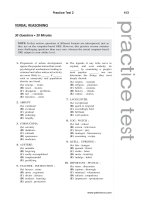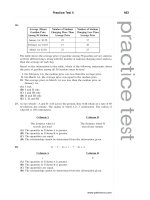Tài liệu Unit_5: The central processing unit pdf
Bạn đang xem bản rút gọn của tài liệu. Xem và tải ngay bản đầy đủ của tài liệu tại đây (36.72 KB, 4 trang )
1
Unit 5
The central processing unit
Control Unit
Arithmetic-logical Unit
Memory of Main storage
It is a common practice in computer science for the words “computer” and “processor” to be
used interchangeably. More precisely, “computer” refers to the central processing unit (CPU)
together with an internal memory. The internal memory or main storage, control and
processing components make up the heart of the computer system. Manufacturers design the
CPU to control and carry out basic instructions for their particular computer.
The CPU coordinates all the activities of the various components of the computer. It
determines which operations should be carried out and in what order. The CPU can also
retrieve information from memory and can store the results of manipulations back into the
memory unit for later reference.
In digital computers the CPU can be divided into two functional units called the control unit
(CU) and the arithmetic-logical unit (ALU). These two units are made up of electronic
circuits with millions of switches that can be in one of two states, either on or off.
The function of the control unit within the central processor is to transmit coordinating
control signals and commands. The control unit is that portion of the computer that directs
the sequence or step-by-step operations of the system, selects instructions and data from
memory, interprets the program instructions, and controls the flow between main storage and
the arithmetic-logical unit.
The arithmetic-logical unit, on the other hand, is that portion of the computer in which the
actual arithmetic operations, namely, addition, subtraction, multiplication, division and
exponentiation, called for in the instructions are performed. It also performs some kinds of
logical operations such as comparing or selecting information. All the operations of the ALU
are under the direction of the control unit.
Programs and the data on which the control unit and the ALU operate, must be in internal
memory in order to be processed. Thus, if located on secondary memory devices such as
disks or tapes, programs and data and first loaded into internal memory.
Main storage and the CPU are connected to a console, where manual control operations can
be performed by an operator. The console is an important, but special purpose, piece of
equipment. It is used mainly when the computer is being started up, or during maintenance
and repair. Many mini and micro systems do not have a console.
2
I. Main idea
1. Main storage is not a part of the processor.
2. The CPU is the made up of the control unit, the arithmetic-logical unit and internal
memory.
3. The CPU is composed of the arithmetic-logical unit and control unit.
II. Understanding the passage
Are these statements True or False?
1. The CPU is made up of three components.
2. The CPU is responsible for all the activities taking place within a computer.
3. The processor itself has three components.
4. The control unit directs the flow of information within the processor.
5. The arithmetic-logical unit of the processor is responsible for the interpretation of
program instructions.
6. The arithmetic-logical unit is also responsible for choosing and comparing the appropriate
information within a program.
7. The processor cannot operate on any information if that information is not in main
storage.
8. Secondary memory and internal memory are located in the same place in the computer
system.
9. Only after the data has been processed by the CPU can results be transmitted to an output
device.
10. Computers can solve problems more quickly if they operate on new information.
III. Locating information
Find the passage in the text where the following ideas are expressed.
1. The processor is the control unit and the arithmetic-logical unit.
2. The processor operates on information that is in internal storage.
3. The CPU directs all the activities of the computer
4. The control unit coordinates the sequencing of events within the processor.
5. The word” computer” usually refers to the CPU plus internal memory.
6. The CPU can get information from memory and put old or new information back into
memory.
7. The arithmetic-logical unit does the calculations and decision-making operations.
IV. Contextual reference
Look back at the text and find out what the words in bold typeface refer to
1. for their particular computer
2. It determines which operations
3. These two units are made up of
4. that can be in one of two states
5. that directs the sequence
6. in which the actual arithmetic operations
7. It also performs some kind of
8. on which the control unit and the arithmetic
3
9. where manual control operations
10. It is used mainly when the computer
V. Understanding words
Find synonyms for the following words.
1. specific
2. decides
3. job
4. movement
5. situated
Find antonyms for the following words
1. exceptional
2. generally
3. not needed
4. taken out
5. shut down
VI. Choose the appropriate form of the words to complete the sentences
1. function, functional, functionally
a. Learning to program is a . . . .. . . . . . . . part of any course in computer science.
b. The central processing unit has many. . . .. . . . . . . .
c. In order for the computer to. . . .. . . . . . . .properly, there should be no fluctuation in the
electric current.
2. sequence, sequential, sequentially
a. the control unit of the CPU directs the. . . .. . . . . . . . operations of the system.
b. Data must be presented. . . .. . . . . . . . to the processor unless the computer is programmed
otherwise.
c. A program must be a detailed account of the. . . .. . . . . . . . the processor must follow to
solve the problem.
3. logic, logical, logically
a. To be a good programmer, one must be . . . .. . . . . . . .in one’s approach to a problem.
b. The. . . .. . . . . . . . operations performed by the arithmetic-logical unit are under the
control of the control unit.
c. A program must be. . . .. . . . . . . . organized if successful results are to be obtained.
4. connection, connect, connected, connective
a. On-line equipment is usually. . . .. . . . . . . . to the computer.
b. Malfunctioning equipment can often be traced to a bad electrical . . . .. . . . . . . .
c. Whether one is writing computer science related information or not, the use of. . . .. . . . . .
is very important.
5. computer, compute, computerized, computed, computation
a. The banking industry has become more and more . . . .. . . . . . . .
b. It is a fact that humans cannot. . . .. . . . . . . . as fast as. . . .. . . . . . . .
c. The. . . .. . . . . . . . requirements necessary to produce the payroll for a large company
take a very long time.
VII. Content review
Use the text you have studied so far to complete the following table.
4
SYSTEM SUBSYSTEMS PARTS FUNCTIONS
Computer Input device
Processor Memory …………………….
……………………
1.. …………………
2…………………..
3…………………..
4…………………..
Arithmetic
……………………..
1…………………..
2………………….
Output devices









